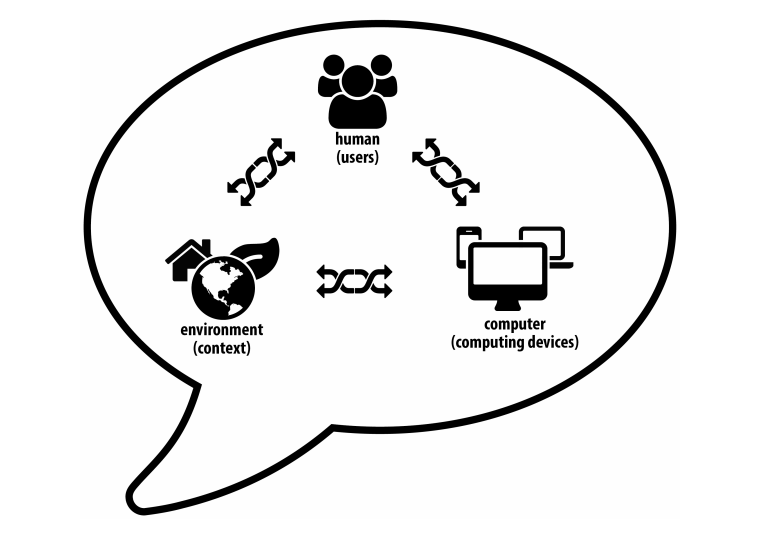This post briefly summarizes definitions of research fields closely-related to natural user interfaces and context-awareness. It is an excerpt from the PhD thesis available here.The aim is to highlight their common ground and to show how all strive towards the same goal: a general improvement in Human-Computer Interaction by bringing the E (as environment or context) in the HCI picture.

The communication triangle of Human-Computer Interaction; communication is possible on all levels, between each pair of the involved entities: human, computer and environment. Two types of arrows represent two types of communication: explicit and mplicit.
The figure above illustrates the communication triangle composed of users, context, and computing devices. Fields concerned with some aspect of this interaction triangle are:
- Intelligent User Interfaces (IUI): “Intelligent user interfaces (IUIs) are human-machine interfaces that aim to improve the efficiency, effectiveness, and naturalness of humanmachine interaction by representing, reasoning, and acting on models of the user, domain, task, discourse, and media (e.g., graphics, natural language, gesture). As a onsequence, this interdisciplinary area draws upon research in and lies at the intersection of human-computer interaction, ergonomics, cognitive science, and artificial intelligence and its subareas (e.g., vision, speech and language processing, knowledge representation and reasoning, machine learning/knowledge discovery, planning and agent modelling, user and discourse modelling)” (Maybury, 1998).
- Ubiquitous Computing (UBICOMP): “Ubiquitous computing is the method of enhancing computer use by making many computers available throughout the physical environment, but making them effectively invisible to the user” (Weiser, 1993).
- Pervasive Computing: “A device can be a portal into an application-data space, not a repository of custom software that a user must manage. An application is a means by which a user performs a task, not software written to exploit a device’s capabilities. And a computing environment is an information-enhanced physical space, not a virtual environment that exists to store and run software” (Saha and Mukherjee, 2003).
- Physical Computing: “Physical computing, in the broadest sense, means building interactive physical systems by the use of software and hardware that can sense and respond to the analog world” (Wikipedia, 2013a).
- Ambient Intelligence (AmI): “Ambient Intelligence (AmI) is about sensitive, adaptive electronic environments that respond to the actions of persons and objects and cater for their needs. This approach includes the entire environment – including each single physical object – and associates it with human interaction,” (Aarts and Wichert, 2009) or from a more philosophical point of view: “Ambient Intelligence is the way for us to re-immerse ourselves in life, and not in technology” (Epstein, 1998).
- Everyware: “In everywhere, all information we now look to our phones or Web browsers to provide becomes accessible from just about anywhere, at any time and this is delivered in a manner appropriate to our location and context” (Greenfield, 2006).
- Internet of things (IoT): “The basic idea of this concept is the pervasive presence around us of a variety of things or objects – such as Radio-Frequency Identification (RFID) tags, sensors, actuators, mobile phones, etc. – which, through unique addressing schemes, are able to interact with each other and cooperate with their neighbours to reach common goals” (Atzori et al., 2010).
Among these research fields UBICOMP is the oldest and perhaps the most influential one. It started considering the environment in HCI and predicted a future where computing devices disappear in the background and users interact with them through the physical environment. The shift from past-HCI to future-UBICOMP-HCI is illustrated in the figure below.

Illustration of HCI’s past (a single user explicitly interacts with a single computer; left) and HCI’s future as envisioned by UBICOMP (many seemingly invisible computing devices available to users, right).


